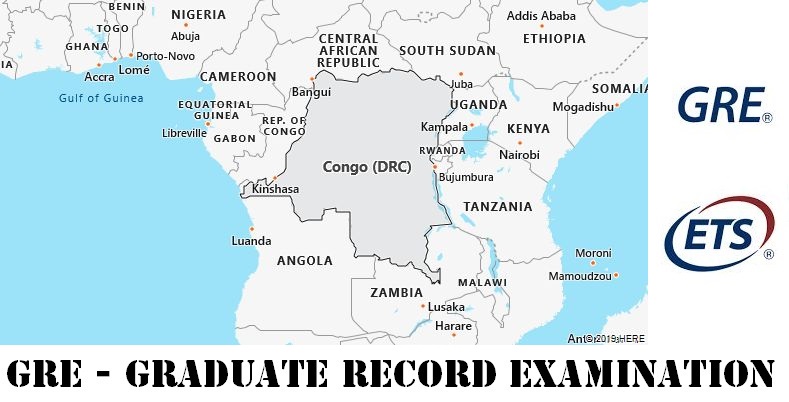GRE Testing Locations
Decided to take GRE exam? Now it is time to determine where to take the test. This site provides a full list of GRE testing centers in Congo DRC, among which, you can choose one that is nearest to you. Good news is that the following GRE test locations in Congo DRC offer both GRE general test and the GRE subject tests.
Paper-delivered Test Centers for General Test
| Code | Name |
| 10310 | U.S. Embassy Kinshasha |
| 10372 | Lubumbashi, TESOL |
GRE Test Dates
There are two types of test format offered by the test maker – ETS: Computer-delivered and Paper-delivered GRE general tests. For computer based test format, the GRE General Test is offered year-round on a continuous basis, and available for registration on a first-come, first-served basis. For paper based general test, testing is available three times per year. The following test dates apply:
| Test Dates for Paper Based | Deadlines for Registration | Scores Available |
|---|---|---|
| November 09, 2019 | October 4, 2019 | December 20, 2019 |
| February 1, 2020 | December 27, 2019 | March 13, 2020 |
GRE Subject Tests in Congo DRC
The GRE Subject Tests are available on paper based only. In all GRE test centers throughout the world (both inside and outside United States), the exam is available three times a year. The three test dates are:
- April
- September
- October

More about Democratic Republic of the Congo
Location
The Democratic Republic of the Congo borders the Central African Republic and the Republic of South Sudan in the north, Uganda, Rwanda, Burundi and Tanzania in the east, Zambia and Angola in the south, the Atlantic Ocean and the exclave of Cabinda (Angola) and the Republic in the west Congo.
Most of the country lies in the Congo Basin and in the area of its marginal sills and is drained by the Congo and its tributaries. In the area of the confluence of the Congo, the Congo has a 40 km long part of the Atlantic coast. The area along the eastern border belongs to the Central African trench with Albert, Rutanzige -, Kiwu – and Tanganjikasee.
The highest peaks are found on the western flank of the trench with the Virunga volcanoes and the Ruwenzori (in Margherita Peak 5,109 m above sea level). The central Congo Basin is 300 m above sea level, while most of the rest of the area is between 300 and 1,000 m above sea level. In the southeast (Mitumbaberge) it reaches 1,890 m above sea level. The Garamba National Park, the Kahuzi-Biega National Park, the Virunga National Park (in which Rwanda and Uganda are part of the Democratic Republic of the Congo), the Salonga National Park and the Okapi animal sanctuary have all been declared UNESCO World Heritage Sites.
Climate
The Congo has a tropical climate, always humid in the north and in the center (main precipitation in spring and autumn), alternately humid in the south (rainy season in summer: November to April). The total annual rainfall in the central part of the Congo Basin is 1,800–2,200 mm, in the south, where two to four arid months occur, 1,200–1,400 mm, in the east, on the windward side of the mountains, also by 1,200 mm, on the leeward side (in the Central African Trench), however, only 900 mm; on the coast there is only 800 mm of precipitation per year. The mean daytime temperatures are balanced all year round (21–28 ° C); in the extreme southeast the winter is colder (16 ° C in July), in the mountains in the east there is occasional frost.
Vegetation
The central and northern part of the Congo Basin is made up of evergreen rainforest, which merges into rain-green wet forest to the north and south, followed by wet savannahs with gallery forests. In the south-east there is rain-green dry forest ( Miombo forest), in the mountains of the east alpine vegetation. There are large populations of mangroves at the mouth of the Congo.
Kisangani
Kisangani, to 1966 Stanleyville [stanlε vil], capital of Orientale Province in the Democratic Republic of Congo, the Congo meters, 428 above sea level (2004) 682,600 residents.
Archbishopric, University (founded 1963), Pasteur Institute, Regional Museum; Food (breweries, rice mills), textile and pharmaceutical, etc. Industry; important traffic junction and transshipment point at the beginning of shipping on the Congo and end point of the railway line from Ubundu, which bypasses the Stanley Falls; Airport.
Kisangani was founded by Europeans at the end of the 19th century.
Kananga
Kananga, to 1966 Luluabourg [lulwa bu ː r], capital of the province of West Kasai, Democratic Republic of the Congo (2004) 720,400 residents.
Seat of a Catholic archbishop; Regional museum (traditional African art); Trade center of a cotton growing area on the middle Lulua; Textile and food industry; Road junction and train station, airport.
Kananga was founded in 1884 as a German military post (Luluaburg).
Mbuji-Mayi
Mbuji-Mayi [mbu ʒ ima ji] until 1966 Bakwanga, capital of the province of East Kasai in the south of the Democratic Republic of Congo (2004) 1.2 million residents.
Catholic bishopric; Diamond mining center; Airport.

